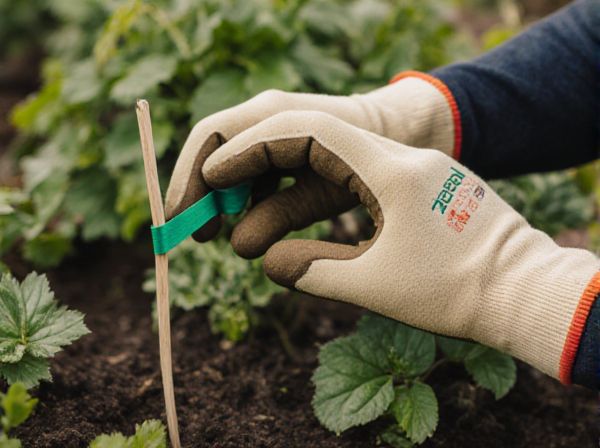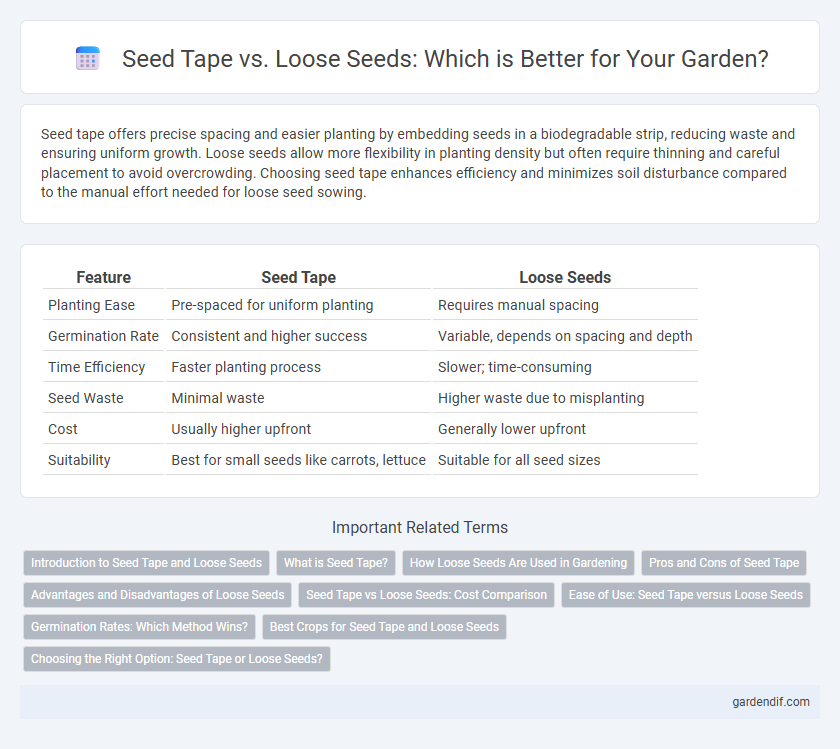
Seed tape vs Loose seeds Illustration
Seed tape offers precise spacing and easier planting by embedding seeds in a biodegradable strip, reducing waste and ensuring uniform growth. Loose seeds allow more flexibility in planting density but often require thinning and careful placement to avoid overcrowding. Choosing seed tape enhances efficiency and minimizes soil disturbance compared to the manual effort needed for loose seed sowing.
Table of Comparison
| Feature | Seed Tape | Loose Seeds |
|---|---|---|
| Planting Ease | Pre-spaced for uniform planting | Requires manual spacing |
| Germination Rate | Consistent and higher success | Variable, depends on spacing and depth |
| Time Efficiency | Faster planting process | Slower; time-consuming |
| Seed Waste | Minimal waste | Higher waste due to misplanting |
| Cost | Usually higher upfront | Generally lower upfront |
| Suitability | Best for small seeds like carrots, lettuce | Suitable for all seed sizes |
Introduction to Seed Tape and Loose Seeds
Seed tape offers a pre-measured, easy-to-use method for planting small seeds evenly, reducing waste and ensuring proper spacing. Loose seeds require manual sowing, allowing flexibility but increasing the risk of uneven distribution and overcrowding. Both options serve distinct gardening needs, with seed tape ideal for beginners and uniform rows, while loose seeds cater to diverse planting preferences.
What is Seed Tape?
Seed tape is a pre-spaced planting medium made by embedding seeds in biodegradable paper or fabric strips, ensuring even seed distribution and simplified planting. Unlike loose seeds, seed tape minimizes thinning by providing precise germination spacing tailored to each plant species. This method enhances seedling success rates and saves time during garden setup, making it an efficient tool for gardeners and farmers.
How Loose Seeds Are Used in Gardening
Loose seeds are commonly used in gardening by sowing them directly into prepared soil, allowing gardeners to control spacing and depth precisely for optimal germination. This method supports diverse plant varieties, including vegetables, flowers, and herbs, enabling tailored garden layouts and crop rotation. Gardeners typically thin seedlings after emergence to ensure healthy growth and prevent overcrowding, maximizing yield and plant vigor.
Pros and Cons of Seed Tape
Seed tape offers precise spacing and easy planting, reducing seed wastage and ensuring uniform crop growth. It is especially beneficial for small-scale gardeners and beginner farmers but can be more expensive and less flexible than loose seeds. However, seed tape may limit seed variety choices and requires careful moisture control to prevent tape disintegration.
Advantages and Disadvantages of Loose Seeds
Loose seeds offer flexibility in planting density and spacing, allowing gardeners to customize arrangements for different crop varieties and garden layouts. However, loose seeds require precise handling to avoid uneven distribution and waste, and they may result in inconsistent germination rates due to variable seed-to-soil contact. Unlike seed tapes, loose seeds demand more time and attention during planting, increasing labor intensity and the potential for seed loss.
Seed Tape vs Loose Seeds: Cost Comparison
Seed tape often reduces overall planting costs by minimizing seed waste and ensuring optimal seed spacing compared to loose seeds, which can lead to uneven germination and higher seed consumption. Although seed tape may have a slightly higher initial price, it saves money on labor and materials by simplifying planting and improving crop yields. Loose seeds are typically cheaper upfront but incur additional costs due to inefficient planting and increased need for reseeding.
Ease of Use: Seed Tape versus Loose Seeds
Seed tape offers superior ease of use compared to loose seeds by eliminating the need for precise spacing and thinning, allowing gardeners to simply lay the tape in the soil and cover it. Loose seeds require careful measurement and manual spacing to avoid overcrowding or waste, often increasing the time and effort involved in planting. Seed tape streamlines the planting process, making it ideal for beginners or those seeking a quick, efficient sowing method.
Germination Rates: Which Method Wins?
Seed tape consistently delivers higher germination rates than loose seeds due to precise spacing and reduced seed displacement during planting. This method minimizes seed wastage and uneven growth by ensuring optimal soil contact and moisture retention for each seed. Research shows germination success with seed tape often exceeds 85%, whereas loose seeds typically achieve around 60-70%.
Best Crops for Seed Tape and Loose Seeds
Carrots, radishes, and lettuce are ideal for seed tape due to their small seeds and precise spacing needs, ensuring optimal germination and growth. Tomatoes, beans, and cucumbers thrive better when planted as loose seeds, allowing for deeper root development and flexible planting depth. Understanding the best crops for seed tape versus loose seeds maximizes garden efficiency and crop yield.
Choosing the Right Option: Seed Tape or Loose Seeds?
Seed tape offers precise spacing and easy planting, reducing the chances of overcrowding and ensuring uniform growth. Loose seeds provide flexibility for varying garden layouts and allow gardeners to plant different seed varieties in desired patterns. Selecting between seed tape and loose seeds depends on your gardening goals, space, and preference for convenience versus customization.
Seed tape vs Loose seeds Infographic

 gardendif.com
gardendif.com